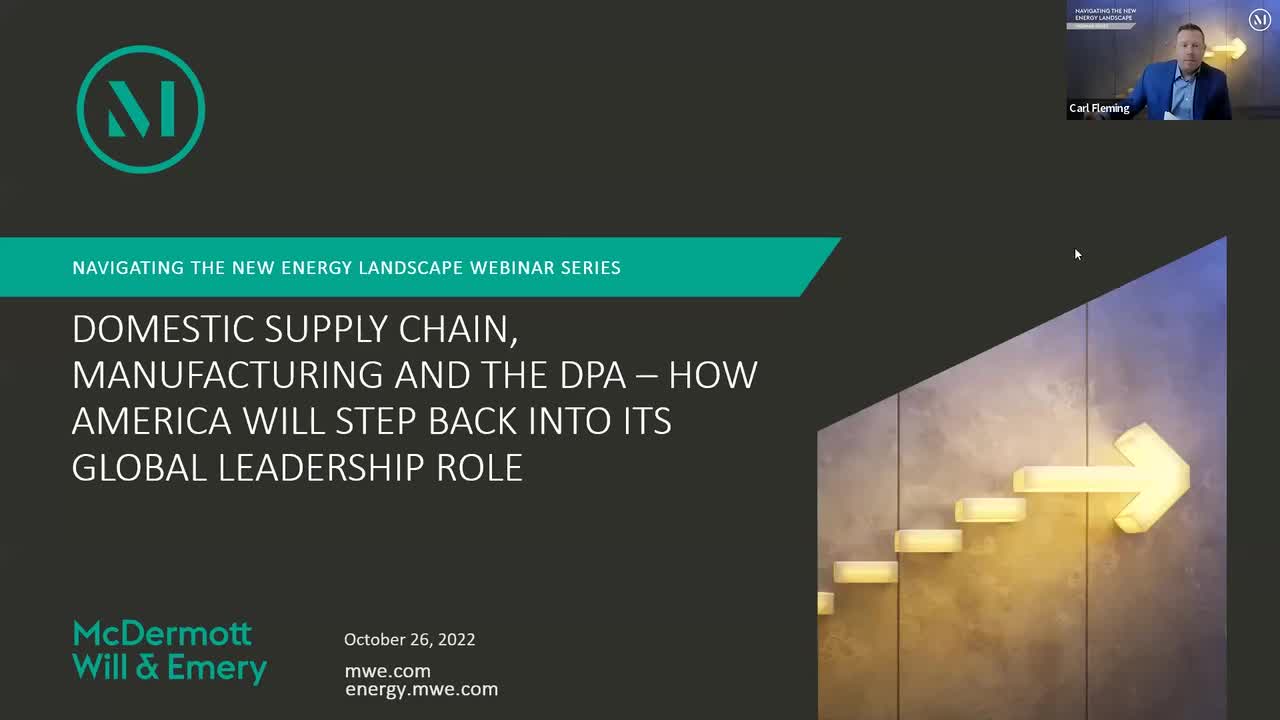The Inflation Reduction Act of 2022 (IRA) is intended to stimulate domestic production in the US energy market and incentivize investment into those projects that utilize such domestic content. On October 26, Partners Carl Fleming and Philip Tingle talked about what the passing of the IRA means for the supply chain (and all its issues as of late), manufacturing within the energy sector, the Defense Production Act and more with guest Brett White, VP of Regulatory Affairs at Pine Gate Renewables (PGR).

Below are key takeaways from the discussion:
1. The IRA Has Already Spurred Investment and Onshoring. The IRA brings improvement to manufacturing and the supply of domestic contents that are capable of bringing a lot of investment opportunities. Investors and manufacturers are already responding positively to it, including module suppliers who are already looking to bring facilities over to the United States. There is still a need for guidance from the US Department of the Treasury (Treasury) and other agencies with respect to regulation, specifically transactable regulations, including comprehensive domestic policy on onshore manufacturing and all the steps it entails. However, the McDermott and PGR teams have already seen a rise in activity surrounding mergers and acquisitions, finance and manufacturing in response to the IRA.
2. Carrot as Opposed to Stick Approach. The domestic content adder is a major carrot to incentivize domestic production, which is quite a contrast to the stick approach that was applied in connection with tariffs and the Auxin investigation. With regards to the tariffs and duties approach and the incentive tax treatment, they do not complement each other; there is a disjointed approach when you look at the tariff items. The Internal Revenue Service (IRS) and the Treasury must issue commercially viable, financially transactional guidance because these incentives are a part of financing for each side of the transaction, the supply chain side and the development side and so it has to be transactable.
3. Need for Further Clarification. The IRS recently issued a request for comments on the domestic content adder, as well as other IRA items. Those comments are due by November 4, 2022. The domestic content adder will be a boon for standing up a domestic supply chain, but the current language requires significant clarification before parties can fully transact. Once that language is determined, this guidance will solidify the number of manufacturers interested in bringing facilities to the United States. While the IRS has a lot on its plate with numerous IRA adders and other legislation, the McDermott and PGR teams see domestic content being among the first items to be clarified within the next few months.
4. Parties Are Transacting on IRA Adders. While some parties are waiting on guidance from the Treasury and the IRS on how they will interpret “manufactured product,” the McDermott team is leading a number of the first domestic content IRA adder tax equity transactions. In those transactions, the parties are willing to finance the underlying investment tax credit (ITC) or production tax credit, commit to financing the domestic content adder and set a limit on that commitment period within which the IRS must issue guidance for the parties to fund. This is allowing several developers to be “first movers” in this space.
5. Section 45X. The IRA has various sections pertaining to domestic manufacturing and its incentives. Among them are section 45X, which is directed at the solar industry in particular. Then there is section 48C, which covers the ITC and is a little broader. Section 45X is what the manufacturing side seems to be leaning toward. Because of the tax credit nature of production, there are many things directly incentivizing it, such as wafers, sales modules and polysilicon. There are also multiple stages in the solar supply chain, and section 45X recognizes that and directly incentivizes the different phases there. Direct pay is a huge part of that. Because manufacturers manufacturing outside the United States want to bring operations over without direct pay, there was no way to capitalize on those types of provisions. Whereas section 48C is not the most user-friendly because of its requirements involving allocation and approval and the strict two-year timeline for the project to be in service, section 45X seems to be more transactable and bankable.
To access past webinars in the Navigating the New Energy Landscape series and to begin receiving Energy updates, including invitations to the webinar series, please click here.


